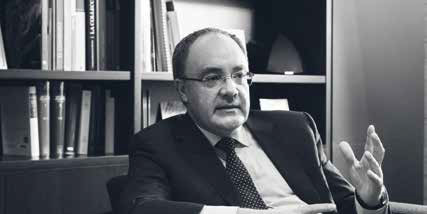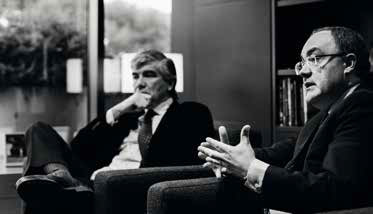connect
people
ANNUAL
REPORT
2016



Question: 2016 was the first full year for Cellnex Telecom as a listed, independent company. In your view, what message would best summarise the achievements of the year?
Francisco Reynés: I would highlight the strong alignment between the objectives set and the results achieved. 20 months after it was floated on the stock exchange, the history of Cellnex continues to embody the outstanding performance of a team maximising our growth options and achieving the right size. Let us not forget that this is a project in which presence in various markets in which our customers also operate and scale are key factors for the sustainability of the business model. In any case, just as important as achieving the necessary size and scale is integrating this growth into the daily activity of the company, in its management processes, ensuring compliance and quality service to our customers. Along with inorganic growth, we must show the market that are able to continue exploiting the organic growth potential of our portfolio of services.
Tobias Martínez: The figures bear out what the Chairman has indicated. The 2016 figures depict a company that closed a financial year with 15% growth in revenue, a 23% increase in EBITDA and a recurring free cash flow that was up 29%. These figures reflect the combined effect of the enlarged perimeter and the organic growth in business.
The information that we present to the market quarter after quarter bears witness to our compliance in both the inorganic and the organic vector. Regarding this last point, the results for 2016 on a like-for-like basis point to 4,5% inter-annual growth in the equipment rolled out in our infrastructures. We have increased points of presence in our locations by more than 200 every quarter, placing the customer ratio at 1,62, compared to 1,53 at the close of 2015. This is occurring in a context in which the telecommunications sector in Europe is not growing, low inflation of 1,1% in 2016 and GDP for the entire EU of around 1,5%.

This organic growth must also be projected onto a continually expanding perimeter, providing greater potential for the company. I think it is worth noting that the company has nearly doubled its revenue in the last four years and has expanded its presence to five countries.
Q: However, after a very positive 2015, the company’s share price has not reflected this positive trend ...
FR: I would underline two elements with regard to Cellnex shares. Firstly, the inclusion in the selective IBEX 35 index, which brings together the main companies of the Spanish stock market in terms of capitalisation and, fundamentally, in terms of trading volume and therefore liquidity. Joining the IBEX 35 helped to broaden the company’s shareholder base, has increased the visibility of our shares and has attracted interest from shareholders who tend to focus on selective stock, providing our stock with greater liquidity.
The second element that I would weigh up here is the relative performance of the telecommunications sector and, more specifically, our comparables in the sector. The financial year was marked by significant volatility with geopolitical factors increasing uncertainty and influencing share prices. In spite of this, the company performed 14% better than the selective IBEX 35 index from its launch onto the market in May 2015 up to the end of 2016.
In this volatile environment it is vital to bring the industrial vision of Cellnex’s model to the fore. Our shareholder base is very solid. Some of the reference shareholders have extended their positions as they share this long-term vision; and the consensus of analysts who follow our company have based their opinion on our fundamentals to maintain a clear recommendation to buy (67%), with a target price well above € 17. Clearly we cannot anticipate changes in the stock market but the company’s fundamentals expressed in the recurrence and strength of its flows, attractive and realistic like-for-like organic growth, and the potential for consolidation in Europe in the coming years provide visibility, solidity and predictability. One fact that backs up this assessment is the portfolio of existing contracts, which was over € 8 billion at 31 December and had increased to € 12 billion following the agreement reached with Bouygues Telecom in France on 1 February to incorporate up to 3,000 new sites over the next five years. This amount is equivalent to 14 years in terms of current revenues.
Q: Cellnex Telecom invested nearly € 1.5 billion in growth operations from 2014 up until the close of 2016. This has diversified its business base and has also expanded its presence in Europe. What is the limit?
TM: The step change in size and the transformation of Cellnex has indeed been remarkable. In four years we have moved from being virtually a single-product company, focused on the broadcasting business, to become a diversified company in which voice and data mobility transmission infrastructure is the driver of growth and which has already taken the lead, accounting for more than 55% of revenue. We have also gone from being a company focused on a single market to become a European company present in five countries with 40% of revenues generated outside Spain.
It is difficult to set the limit. That will be the result of a combination of factors. Of our ability to continue to demonstrate the effectiveness of a business model based on the concept of neutrality and independence that lends credibility to the network access operators that are our customers and which, thanks to this neutrality, feel compelled to outsource infrastructures which, still today, they mostly hold on their balance sheets.
We need only to see that in the Europe of 28 there are more than 300,000 towers and sites, only 11% or 12% of which are run by independent operators. In the U.S., more than 80% of non-urban sites are outsourced, as are almost 35% of the total, if we include the urban ones. This market did not exist in Europe just five years ago. The potential is therefore enormous. I am sure the limit will be marked more by the speed at which network access operators outsource, and the capacity that we have as infrastructure operators to integrate these assets both from a financial and a management point of view.
Let us add, in the medium term, what may result from the need to densify the existing network of sites, the connectivity of which must be improved with optical fibre, supplemented with what are known as small cells, which will be both a structural element in the urban public space, as in large buildings, stadiums, shopping centres, etc. Only then will it be possible to ensure reliable access to permanent uninterrupted network coverage with sufficient capacity for applications based on the new 5G standard and the emerging IoT. This is a much more demanding connectivity based on a network that above all must be resilient with no more “blank spaces” without proper coverage and capacity.
Q: If the limit is not in the potential market, it could be in the capacity to finance this growth. What is Cellnex’s strategy regarding management of its balance sheet?
FR: Cellnex has a very stable debt structure. The corporate bonds issued in 2015 (€ 600 million) and 2016 (€ 750 million in August and € 65 million in December), will mature only in 2022, 2024 and 2032 respectively. There is a fixed interest rate for 86% of the debt with an average cost of 2.6% at the close of 2016, which is among the lowest of listed companies in Spain. The company also has access to immediate funding lines which, together with its cash and banks position, stand at € 1.8 billion.
TM: With this debt structure, and considering that market trends continue to point to low interest rates - even considering the change of trend brought about by the Fed - and that the liquidity of debt markets remains high, the first option for funding new operations would be access to borrowing. Let us not ignore the company’s powerful cash generation that helps it reduce the net debt/EBITDA ratio to a multiple of 0.6x each year. In any case this does not exclude us from assessing other instruments, such as bringing financial partners on board, which may be considered according to the type of growth operations that the company could undertake.
Q: In a young company like Cellnex, from the point of view of its IPO and its entry into the IBEX 35, rolling out the model of corporate governance and the policies that accompany it is key. What were the milestones in this area in 2016?
FR: Our youth has partly been an opportunity, which we have seized, to establish a very compact corporate governance right from the outset, with 9 directors, extendible to 13, of which 4 are independents who also chair both of the Board’s committees - Audit and Control and Appointments and Remuneration.



We can say that the degree of compliance with the recommendations of the Code of Good Governance is high. We can improve on this, and are committed to doing so. At the General Shareholders’ Meeting for the financial year 2015 we indicated that we planned to increase our base of independent directors, which is already large. This has already happened, and we shall be submitting a proposal to the Shareholders Meeting for FY 2016 to increase the Board to ten members, bringing in the new independent director Marieta del Rivero. In this way we have bolstered the number of independents and are moving forward to comply with recommendations on gender diversity.
2016 was very much the continuation of our approach in 2015 to formulating and rolling out all the policies for ensuring consistency in the governance of the entire company in each of its business areas and functions as well as in the various countries. This is perhaps one of the main challenges we face, since growing in various countries also means ensuring that they all adopt the same criteria and that we can work guided by shared values and principles.
Formulating and disseminating policies - corporate responsibility, company fiscal strategy, the rules of procedure of the General Meeting and the Board themselves, as well as the Internal Code of Conduct, or extension and effective enforcement to prevent corruption, making available the ethical channel, and the work of the Ethics Committee and compliance - are bringing us ever closer to the standards of the best out there.
TM: Transparency is one of the clearest indicators for gauging the degree of compliance with good corporate governance and correspondence with the best practices in this field. In this regard it is worth recalling here that Cellnex Telecom has been ranked second by the Chamber of Commerce of Barcelona among the 30 companies analysed by the Chamber in a study1 in collaboration with the Institute of Financial Studies - including virtually the entire IBEX 35 - for quality, reliability, frequency and scope of the information that publicly-held companies release to the markets, their stakeholders and shareholders.
Q: Turning to Good Corporate Governance, you have referred to the formulation of the Corporate Responsibility policy. What progress has been made in this area?
FR: Having a properly formalised policy does not make us more responsible as a company. That responsibility comes from all of us who are part of the Cellnex project acting individually in a responsible way and because we share a set of values and principles that reflect a way of understanding the market that is based on competencies, and by extension on innovation and merit as our watchwords. With programmes aimed at building our teams’ capacities, identifying talent, strengthening it, promoting employability, growth from a gender diversity and origin perspective. Taking part in programmes to support initiatives that promote the transfer of knowledge in the form of applied innovation and entrepreneurship projects. This an open innovation formula that combines knowledge-creation and innovation, which is fitting for a company with its own driving force, with access to advanced information regarding the state of the art of technology and new developments that can impact on our business model in one way or another.
TM: As part of this process of building the project and gradually adopting policies and best practices, in 2016 we began the actual rollout of the five pillars on which the Corporate Responsibility Plan 2016-2020 is built. Here are some figures that show the progress achieved: 76% of the lines of action structuring the Plan are already underway and 34% of the actions have already been achieved. Our ambition is to gauge our compliance step by step. During 2016 we conducted a “shadow rating” analysis to compare our progress in relation to some of the leading global sustainability indices, including the Dow Jones Sustainability Index. This allows us to identify our weaknesses - and our strengths - and therefore indicate where we need to apply measures for improvement. That said, it should also be noted that, according to the information reported to the Carbon Disclosure Project (CDP), Cellnex Telecom was rated as the best Spanish company that had joined the CDP2 in 2016 to compare the company’s progress in sustainability and its environmental impact.
Q: And finally, what can we see in terms of what financial year 2017 might hold?
TM: We need to differentiate clearly between inorganic growth and like-for-like growth. We have already mentioned this. The underlying conditions in the telecommunications sector in Europe are not going to change to any large degree. It is a mature market with well-established players in which the base of end customers is not growing, while competition in the supply of services and prices is. This will continue to exert pressure on the margins of all industry players: we must continue to invest by offering content and services based on broadband services and will need to continue investing in infrastructure and equipment that can ensure the provision of current and future services. The value proposal of operators like Cellnex can be attractive for network access operators - our customers - to improve their profitability by reducing their network operation costs by outsourcing it and sharing it through a neutral operator. That trend is hard to reverse and will continue to increase over the coming years beyond 2017. Therefore, on a like-for-like basis, organic growth understood in terms of site occupancy ratio and the amount of equipment installed in these sites, we think will continue to grow at around 3% - 4%. Placing this in a context of relatively low inflation, of a broadcasting business with a still significant and solid weight but stable in its key figures, and with European GDP experiencing moderate growth, we understand these key figures are at once reasonable and attractive. In any case, it is a growth on the basis of a perimeter that can continue to expand via new acquisitions and business lines such as DAS, small cells or Internet of Things solutions, which are going to increase in volume and weight over the coming years. Cellnex is aligning results and expectations thanks to a combination of ambition and realism.
1. “Llotja” 2016 Award
2. “Best newcomer Spain” during the “CDP Climate Leadership Awards 2016” awards ceremony. Madrid, 25 October 2016
GRI: G4-DMA, G4-1, G4-2, G4-14, G4-37, EC2
We use our own and third-party cookies to improve our services and show you advertising related to your preferences by analysing your browsing habits. If you continue to browse, we understand that you accept the use of these cookies. You can change your configuration or obtain further information Cookies Policy. Accept